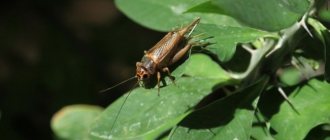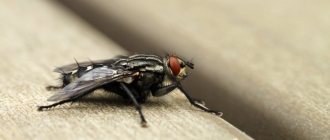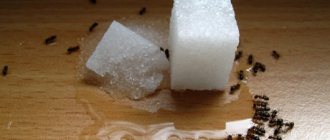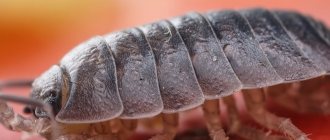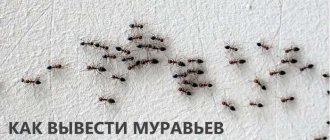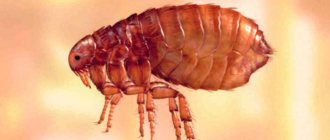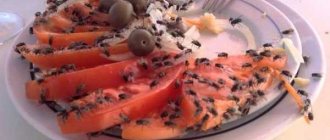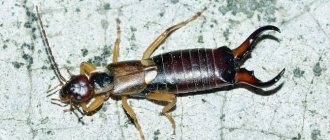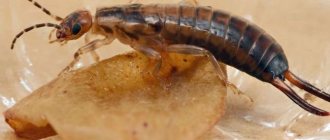What does a cricket look like? This insect of the family Gryllidae belongs to the grasshoppers. It has a cylindrical body, a round head and long antennae. The abdomen ends in a pair of long cerci; females have a long cylindrical ovipositor.
The hind legs have an extended femur, which provides strength for jumping. The front wings are hard and leathery, and some crickets chirp while rubbing them. The hind wings are membranous and folded when not used for flight. Many species do not fly. The largest are bull crickets, brachytrupes, up to 5 cm long.
More than 900 species have been described. Distributed throughout the world except at latitudes 55° and above, with greatest diversity found in the tropics.
Crickets are nocturnal, known for the loud, insistent song of males trying to attract females, although some species are mute. Singers have good hearing thanks to the eardrum on the shins of the front legs.
They are kept as pets from China to Europe, sometimes for fighting. They are eaten in Southeast Asia. Used to feed predatory animals in zoos. In Brazilian folklore, crickets are an omen of various events.
Description
Crickets belong to the order Orthoptera, which includes grasshoppers and locusts . These are small and medium-sized insects with cylindrical, vertically flattened bodies. The head is spherical with long thin antennae, behind them are two large compound eyes. There are three ocelli (simple eyes) on the forehead.
The first thoracic segment is trapezoidal in shape and strong. The insect is smooth and has neither dorsal nor lateral ridges.
At the tip of the abdomen there is a pair of long cerci (paired appendages of the posterior segment). In females, the ovipositor is cylindrical, long, narrow, smooth, and shiny. The hips of the rear pair of legs are significantly widened for jumping.
The tibiae are armed with several movable spurs, the arrangement of which is characteristic of each species. The tibiae of the front legs are used to receive sound.
The wings lie on the body and vary in size among different species. The front wings are made of durable chitin, acting as a protective shield for the soft parts of the body.
Males have stridulatory organs for producing sound. The hind pair is membranous and folds fan-shaped under the front wings. Many species have wings that are not adapted for flight.
The largest are the 5 cm long bull crickets (brachytrupes), which dig burrows a meter or more deep. Oecanthinae, arboreal insects are delicate white or pale green insects with transparent fore wings, field insects (Gryllinae) are strong, brown, black.
When they chirp
In most cases, you can only hear a cricket chirping at night. That's when the musicians come out of their holes. Although in country fields you can enjoy the trill at any time of the day. During mating games, insects can play music both day and night. Silencing an Orthoptera is very easy. He stops singing as soon as he senses danger. Therefore, at the slightest approach to him, the male hides in a hole.
The simplicity of the grasshopper's acoustic organ prevents them from chirping at night. At this time, dew falls in the grass and the wet organ is not able to emit trills. The sound of the green insect can only be heard during the daytime.
In Japan, little musicians are especially respected. They are bred specifically to be able to listen to melodious ringing at any time.
The working rhythm puts a lot of stress on the nervous system. And a person wants to relax, forget about work. It is especially difficult to work in the city in the summer, when vacation will only be in winter.
To keep your nervous system healthy and not lose performance, you just need to go out of town or climb into a remote place in a city park. And as soon as you spend a little time in silence, the music of nature begins to flow - the chirping of grasshoppers.
Habitat
They live in all parts of the world, with the exception of cold regions, latitudes above 55° north and south latitudes. The greatest diversity is found in tropical locations such as Malaysia, where 88 species can be heard chirping near Kuala Lumpur.
Members of several subfamilies live on the tops of trees, bushes, and among grasses. They are found on the ground, in caves, some are underground, digging shallow or deep holes. Others live in rotting wood, on the beach, and can run and jump on the surface of the water.
Chirping
Most crickets make a loud sound, stridulation. The stridulatory organ is located on the forewing, which has a leathery structure.
Find out more The largest insects on Earth
The calling song attracts females and repels other males, and is quite loud. The aggressive song is triggered by contact chemoreceptors on the antennae, which detect the presence of a rival.
Crickets chirp at different rates depending on the species and the temperature of the environment. Most chirps faster at higher temperatures (62 chirps per minute at 13°C.
The relationship between temperature and chirp frequency is known as Dolbear's law. According to this law, counting the number of chirps made in 14 seconds and adding 40 gives the temperature in degrees Fahrenheit.
Ground crickets (Nemobiinae) are wingless, others have small fore wings and no hind wings (Copholandrevus). Gryllus assimilis are efficient and good fliers, others are clumsy fliers.
Video
And in conclusion, we invite you to listen to the sound of a cricket in the video yourself.
Author: Pavel Chaika, editor-in-chief of Poznavaika magazine
When writing the article, I tried to make it as interesting, useful and high-quality as possible. I would be grateful for any feedback and constructive criticism in the form of comments on the article. You can also write your wish/question/suggestion to my email [email protected] or Facebook, with respect, the author.
Author page
What do crickets eat and do they bite people?
House crickets are omnivores. Deprived of natural nutrition, they consume a wide range of organic foods. Some are completely herbivorous, feeding on flowers, fruits, and leaves. Terrestrial species consume seedlings, herbs, pieces of leaves, and shoots of young plants.
Others are carnivorous, eating invertebrate eggs, larvae, pupae, scaly insects, and aphids. Many are scavengers, consuming organic remains, decaying plants, and fungi. In captivity, house crickets have been successfully raised on dry dog food with the addition of lettuce and aphids.
They have relatively strong jaws, and several species bite humans.
Insect nutrition
In their natural environment, crickets feed on fresh grass shoots and bush leaves. Having settled on the site and significantly increased the population, they will begin to harm garden crops. Adults prefer to nibble on seedlings rather than weeds. Their diet is not limited to plant foods; insects require protein for development. Its source is small insects, corpses or their own offspring.
What does a cricket eat when it finds itself at home? In this case, he shows omnivorousness, eating crumbs of bread, droplets of liquid dishes and drinks, pieces of vegetables and fruits with equal pleasure. Meat or fish that falls on the floor will also be eaten by the little neighbors. Showing the instincts of a hunter, they can catch flies or small invertebrates that end up in the house.
Many seemingly harmless insects turn out to be a source of danger, so the question often arises: do crickets bite? You can rest assured about night singers, they don’t bite people. The jaws of the gnawing type are not adapted for attacking large objects; moreover, aggressiveness is shown only towards males in foreign territory.
Life cycle
Male crickets establish dominance over each other through aggression. They start by hitting each other with their antennae and inflating their mandibles. If they do not retreat at this stage, they resort to fighting, each making sounds completely different from those heard under other circumstances. When someone wins, he sings loudly, the loser is silent.
Females are attracted to males by song. After mating, the female eats the spermatophore (the male's reproductive organ).
Eggs are laid on the soil, in plant stems. To do this, females have a long, needle-shaped ovipositor. Terrestrial inhabitants do without this, either placing the eggs in an underground chamber or pushing them into the wall of the hole.
The short-tailed cricket (Anurogryllus) digs a chambered burrow, lays its eggs in a pile on the floor, and feeds its young for about a month after the eggs hatch.
These are hemimetabolous insects - the life cycle consists of an egg stage, a nymph, which resembles the adult form, the adult. The egg grows into a nymph about the size of a fruit fly.
The nymph goes through about 10 stages, becoming more like an adult with each successive molt. After the last molt, the genitalia and wings are fully developed, but a period of maturation is required before the insect is ready to reproduce.
Relationships with a person
Cricket
A very difficult topic for cricket. In Japan, it was customary to keep these insects at home in miniature cages. In Asia they are specially bred for food; in North America they are used as bait. In Russia today, many exotic animal lovers keep reptiles that eat crickets. Owners of these cold-blooded animals, along with reptiles, usually breed crickets as food for their pets.
If a cricket suddenly appears in a multi-storey building in the city center, you can be sure that it has escaped from a pet reptile lover. Much less often such escapes occur from insect lovers due to the fact that they also prefer to keep exotic crickets.
On a note!
There is nothing to worry about if this insect has settled in your home. Although it is related to cockroaches and can feed on similar foods, it does not cause any damage. Night Grasshopper is neutral. It does no harm or good. Except for nighttime singing, which can interfere with sleep.
Pets and for fighting
Crickets are kept as pets. An insect singing in the house is a sign of good luck and potential wealth. They are so treasured that they are often displayed in beautiful bamboo cages.
In China, Japan, and some European countries, especially on the Iberian Peninsula, they are kept in cages or hollowed out pumpkins, specially created forms. Insect fighting is a traditional Chinese pastime that dates back to the Tang Dynasty (618–907).
Find out more Midges in the apartment, where to get rid of them and how to get rid of them
The dominance and fighting ability of males depends not only on strength. They have been found to become more aggressive after isolation, or when defending a refuge. Forced to fly briefly, crickets fight two to three times longer than they otherwise would.
Foreign superstitions
There are many myths about insects that are relevant among representatives of different nations. The Chinese are confident that they help prolong life. Therefore, they believe that they should be started at home.
Acheta domesticus
The Indians used crickets to prepare a special tincture that helped a person become more resilient, faster, and physically stronger.
The Japanese believed that musical insects could be tamed and settled them in their homes. It was believed that sitting next to the house, crickets sing for their owners, thereby lulling them to sleep. But if someone unfamiliar approaches the house, the insects immediately fall silent, warning that a stranger is coming to the house.
In Brazil, they believe that the singing of an insect attracts death.
There are many superstitions associated with crickets - they can warn of both bad and good events, and attract happiness and good luck into the house. Therefore, do not rush to drive away such a little messenger, even if he disturbs sleep with his night trills.
Are they eaten?
In southern Asia, including Cambodia, Laos, Thailand, Vietnam, insects are eaten as a snack made by deep-frying soaked and cleaned insects.
Cricket flour is used as an additive in consumer products such as pasta, bread, crackers, and cookies. Flour is used in protein bars, pet food, livestock, and industrial purposes.
They are bred as food for zoo carnivores, laboratory animals, and domestic animals.
They have a high protein and calcium content. Every 100 grams of insects you eat will provide 13 grams of protein and 76 milligrams of calcium.
How to get rid of crickets
For some, the sound of crickets evokes images of sultry summer nights; for others, the incessant chirping only evokes rage. Do house crickets bother you? If so, try strategies to get rid of them.
Chirping in the yard: a familiar sign of summer. For some people, this sound has no charm; if you are unlucky enough to have a chirper living right under your bedroom window or sneaking into the house, the sound becomes a nightly nuisance.
Unfortunately, to get rid of crickets, you need to do more than just stand outside the door and yell, “Quiet!” Crickets do not listen to commands, no matter how desperate or heartfelt they may be. But there are other, more complex tactics that are being responded to. Read on to find out how to get rid of them.
Step 1: Find the source
The first and most difficult step is to find out where the crickets are hiding. It's best to follow the sound of chirping. Keep in mind that as you approach or near the nest, they will become quiet, hindering your efforts. Despite this, hearing helps narrow the search field.
When looking, focus on features that provide cover, as crickets like to nest in dark, damp environments. Look under the layers of mulch, the compost pile.
If you can find the nest, there are two options. One is to stop watering that part of the property, depriving the crickets of the water they need to survive. A slightly more radical method is to fill it with water. The goal is to force the singers to leave the nesting site.
For a lasting solution to the problem, we need to go even further. Because as soon as you resume regular watering, the crickets may return. To prevent this from happening, be sure to use expanding foam to fill any pockets you find.
Step2: Do it yourself or buy a pesticide
Crickets seeking shelter enter the house through foundation cracks and tiny holes around windows and doors. If it is too late to prevent access by sealing the building envelope, there are several ways to get rid of crickets that have found their way inside uninvited.
Don't discount the classic sticky traps and glue boards. If you're looking for an easy, inexpensive method, look no further than your kitchen pantry. A flask filled with a 1:10 mixture of molasses and water works great. Crickets attracted to the jar by the sweet smell will not be able to escape and will drown.
Alternatively, choose a store-bought pesticide spray. Follow the instructions carefully, and be aware that house crickets like to sit where it is dark and damp. Therefore, concentrate pesticide applications in the most likely areas, such as under the kitchen sink.
Find out more Mantis bite: danger to humans
Step 3: Preventive Exterior Maintenance
Since you're dealing with an infestation, it's important to take steps to prevent it from happening again. No matter how well your home is sealed, it will never be completely bug-free, despite your best efforts.
Mowing the lawn, weeding the garden beds, clearing out yard debris—removing hiding spots—all discourage crickets. Also, try to create distance between the house and its landscaping by trimming bushes near the foundation. If you have a supply of firewood, try to store the logs away from the house. And don't forget to clean your gutters, they're a notorious haven for pests.
Finally, since light attracts crickets, consider limiting the use of outdoor lighting or switching to motion sensor lights.
Feeding frequency
Dry food should be present to insectaries at all times.
This is also interesting: How to fight slugs in the garden with improvised means
To avoid rotting, it is better to give succulent food (carrots, apples, cabbage, rutabaga) 1-2 times a day, after grating it on a coarse grater. A small portion, placed on a bowl, is left in the insectarium for an hour to an hour and a half, and then removed. At the next feeding, a new batch of grated feed is prepared. The same goes for pieces of meat.
Recommendation: water should always be freely available to insects . However, you should not put a drinking bowl in the insectarium - young crickets can drown in it. is much more convenient to use a foam sponge soaked in water . You need to make sure it doesn't dry out!
Jerusalem crickets
Seeing a Jerusalem cricket for the first time is an unsettling experience even for those who are not prone to entomophobia. They look like giant, muscular ants with humanoid heads and dark beads. Although Jerusalem crickets (family Stenopelmatidae) are indeed quite large, they are harmless.
What they look like
In the 19th century, people used the expression "Jerusalem!" as a curse word, and this is believed to be the origin of the name.
People also believed (incorrectly) that these strange insects with human faces were highly poisonous and potentially deadly, so they were given nicknames rife with superstition and fear: beetles with bones on their necks, an old man with a bald head, the face of a child, the Child of the Earth (Niño de la Tierra). Among entomologists they are called sand or rock crickets.
Jerusalem crickets are 2–7.5 cm long and weigh up to 13 g. Most of these flightless insects are brown in color and have a striped belly with alternating stripes of black and light brown.
They are quite large, with strong bellies and large round heads. They do have strong jaws and can deliver a painful bite if handled incorrectly. Some species jump to avoid danger.
What do they eat
Jerusalem crickets feed on soil organic matter, both living and dead. Some collect garbage and hunt other arthropods.
They practice cannibalism on occasion, especially when they are together in captivity. Females often eat partners after the relationship ends (similar to mantis cannibalism , which is better known).
Special behavior
The insects wave their spiny hind legs in the air to ward off perceived threats. They are an important food source for bats, skunks, foxes, and coyotes.
If the predator manages to pull out the leg, the Jerusalem nymph will be able to regenerate the missing limb.
Reproduction
Reproduction of crickets occurs when the insects create comfortable conditions and an abundance of food. In a population, there must be at least 4 females per 1 male, otherwise deadly struggles and deafening crackling are guaranteed. A small container (4 cm deep) is placed in the container, into which wet peat, sand or plain soil is placed. Soon the females will lay their eggs here. To avoid destruction of the clutch by males, this container should be covered with a fine mesh or strainer. Soon the larvae will appear, which after a few molts will become adults.
Raising crickets at home is a fairly simple task. The main thing is to create suitable conditions - temperature, humidity and refreshment, and then give your pets the required amount of food: dry and wet. Females are quite undemanding to conditions, so very soon the population will begin to rapidly increase.
Cricket farming is big business
Thanks to the demand created by owners and breeders of reptiles that eat crickets, breeding is a multi-million dollar business. Large breeders raise up to 50 million insects at a time in warehouses. The common house cricket, Acheta domesticus, is raised for trade as a pet.
Source
Jerusalem Crickets (Orthoptera, Stenopelmatidae), by David B. Weissman, Amy G. Vandergast, and Norihimo Ueshima. From Encyclopedia of Entomology, edited by John L. Capinera. “Crickets and Temperature,” University of Nebraska-Lincoln Department of Entomology. Cranshaw, Whitney and Redak, Richard. “Bugs Rule! An Introduction to the World of Insects.” Elliott, Lang and Hershberger, Wil. “The Songs of Insects.”
References:
- Gorokhov, A.V. Life forms of crickets (Orthoptera, Grylloidea) of Central Asia / Gorokhov A.V. // Entomol. review – 1979.- T.58, No. 3.- P.506-521.
- Gorokhov, A.V. On the morphological criteria of the genus in crickets (Orthoptera, Grylloidea) / Gorokhov A.V. // General entomol. – L.: Science – 1986. – T. 68. – P. 17-19.
- Zhantiev, R.D. Bioacoustics of insects / R.D. Zhantiev. – M.: Publishing house Mosk. University, 1981. – 256 p.
- Zhuravlev, Yu.D. Insect cultures used for feeding amphibians and reptiles in the terrarium of the Almaty Zoo / Zhuravlev Yu.D., Pugacheva N.A. // Scientific research in zoological parks. – M., 1994. – Issue. 4. – pp. 110-111.
- Knyazev, A.N. Developmental cycle of the cricket Gryllus bimaculatus Deg. (Orthoptera, Gryllidae) under laboratory conditions / Knyazev A.N. // Entomol. review – 1985. –T.64, Issue 1. – P. 58-74.
- Yasyukevich, V.V. Cultivation of crickets for feeding exotic animals / Yasyukevich V.V., Rivkin L.E. .// Scientific materials - practical conf. Animal culture and biological resources. – M.: Scientific T. ed. KMK., 2005. – pp. 146-148.
- Alexander RD The evolution of genitalia and mating behavior in crickets (Gryllidae) and other Orthoptera / Alexander RD, Otte D. // Misc. Pabl. Mus. Zool. Univ. Michigan. – 1967. – Vol. 133. – R. 1-62.
- McFarlane JE Studies on group effects in crickets / McFarlane JE // Can. J Zool. – 1984. – Vol. 44. – P. 1017-1021.
- Wineriter SA Group and individual rearing of field crickets (Orthoptera: Gryllidae) / Wineriter SA, Walker TJ // Entomol. News. – 1988. –Vol. 99, No. 1. – P. 53-62.
- Wyniger R. Insektenzucht / R. Wyniger. – Stuttgart: E. Ulmer Verlag, 1974. – 368 rub.
